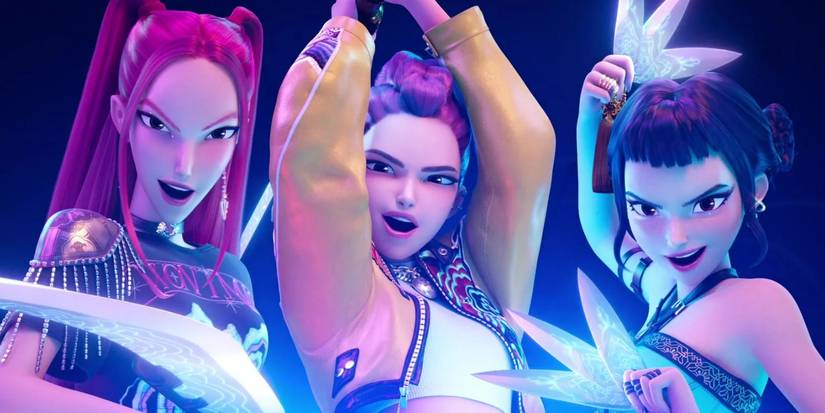It’s safe to say that KPop Demon Hunters took the world by storm after its August 23 release; it became Netflix’s most-watched movie ever, immediately spawned talks of a sequel, and found its way from the streamer to movie theaters for special sing-along screenings. All that thanks to the movie’s infectious blend of humor, music, and a grippingly emotional story.
Because of that blend, the filmmakers behind the critically acclaimed KPop Demon Hunters had quite a challenge ahead of them. Not just first-time director Maggie Kang and co-director Chris Appelhans, either; creatives like sound designer, supervising sound editor, and re-recording mixer Michael Babcock found ways to combine K-pop music techniques with the necessities of action movie filmmaking.
ScreenRant interviewed Michael Babcock about his work on KPop Demon Hunters. Babcock discussed some of the biggest challenges he faced in crafting the sound of the movie’s world, and revealed how some of the movie’s standout moments were created. Plus, he revealed how he took cues from the movie’s chart-topping music in how he approached his craft.
KPop Demon Hunters Is Musical, Even When It’s Not
Michael Babcock is not only a sound designer, editor, and mixer whose credits include Inception, Dune: Part Two, and Doctor Sleep; he’s also a musician. That skillset was helpful on KPop Demon Hunters, a project he described as “one of the most creative challenges I’ve been a part of.”
The reason for that, Babcock said, was that “every aspect of the sound is handshaking with each other.” The need for a cohesive sound inspired Babcock to turn to K-pop itself for cues on techniques. “K-pop music in general is very highly polished,” he said, “[with] a lot of wonderful engineering. There’s a lot of attention to detail.”
From that, Babcock chose to use “some of the same thought concepts and some of the same tools you’d use to make a K-pop song” for the movie’s sound. That included using genre-standard reverbs and delays, and working with the music team to see how they were shaping the sounds of the movie’s infectious songs.
How Billie Eilish Helped Create The Voice Of Demons
KPop Demon Hunters also steps beyond the mortal realm, and Babcock had to come up with the sound of the movie’s demons, led by the malevolent Gwi-Ma. That’s where Billie Eilish, and other artists, came in.
“The first thing [the directors and I] talked about, creatively, was the processing of the voices,” Babcock said. “They gave me a playlist of a bunch of different pieces of music with vocal processing that they liked.”
“It wasn’t just K-pop music that they sent me,” he continued, “it was Billie Eilish [and] Imogen Heap, and a bunch of artists that are pretty obscure, but would have an interesting vocal performance that [would] be manipulated later, like stutter [manipulation] or a really weird computer-generated harmony delay.”
“At the end of the day, [the demon sound] was a little bit of pitching and a little bit of chorus/harmonization with a tremolo-type stutter to it.”
The demon voice had to work for Gwi-Ma, Rumi in her demon moments, and garden variety monsters alike, but it also had to work with, and occasionally within, the movie’s songs. “[The demon voice] sounds musical, but it’s also not music, which is what it had to be,” Babcock said.
Demon Death By Tuning Fork
There’s quite a bit of action in KPop Demon Hunters, with HUNTR/X members Rumi, Mira, and Zoey wielding specialty weapons that help them get the better of their enemies. Those scenes gave Michael Babcock another opportunity to design sounds that fit seamlessly into a musical world.
“What I tried to do on this was use certain music tools and stay in a music theme in an organic way,” he said, “and probably the most obvious thing you can hear [that] in is the girls’ swords. They wanted the swords to be slightly magical, but also, they look like swords.”
“There also has to be a musical genesis to it,” Babcock added, specifically citing the fact that the swords are used even during musical numbers. “So, what I did with that is, I went on Amazon and I bought a bunch of tuning forks,” Babcock revealed, “and recorded them at high bit rates and manipulated them.”
“It has this resonance like a sword would, and you can move it and manipulate it like a sword, but it’s derived from a musical thing, and that got pitched to the music.” What that means, Babcock elaborated, is that “whenever it’s against music, it’s matching the pitches of the music, or works with either the score or the song.”
The Secrets Of Derpy Tiger
Babcock revealed that a surprisingly difficult scene in KPop Demon Hunters was the one in which a mysterious tiger delivers Rumi a message from the demon Jinu. The scene transitions from creepy to cutesy in moments, with plenty of help from the sound design.
“It’s more of a challenge to make something cute than it is scary,” Babcock reflected, “and the tone of this entire movie is warm [and], in place, cute. That scene is a real contrast and was a real challenge … Every little sound you hear in there is intentional.”
The creaking of the floor under the tiger’s paws made its arrival surprisingly tense given its friendly features, but the sounds of the creature itself were much more in line with its appearance. “Every single footstep of that cat, every single movement, is actually a pillow poof,” Babcock revealed.
“[It’s] the sound of a pillow either being hit or being slammed on the ground,” the sound designer continued, “it has this softer [sound], and you can manipulate it to make it sound really big and deep.”
“Making it cute but somehow heavy and somehow slightly threatening at the beginning… that was a huge challenge.”
KPop Demon Hunters is out on Netflix.









